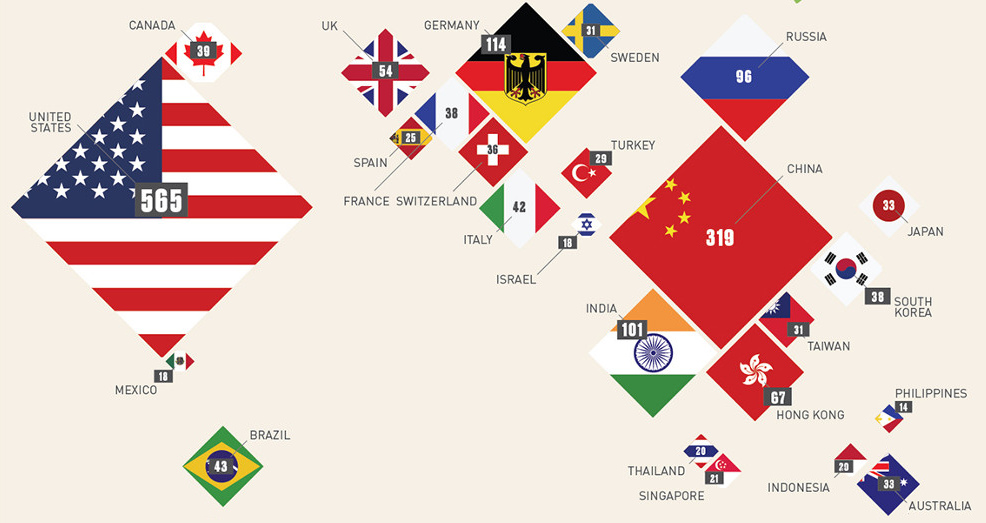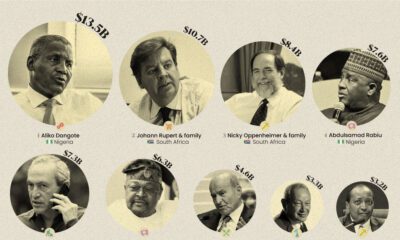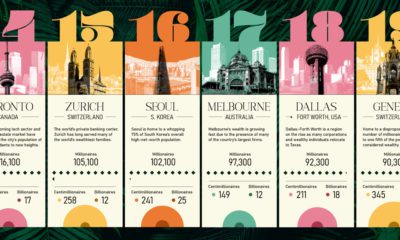That means if you meet someone from the global population at random, there’s a 1 in 200 chance that they could be a millionaire – this makes for surprisingly good odds. However, the billionaire on the other hand is a much rarer breed. According to Forbes, there are just over 2,000 billionaires in existence, making up just 0.00003% of the global population. Where do these people live, and what countries have the highest concentrations of them as citizens?
25 Countries That are Rich in Billionaires
Today’s infographic comes to us from TitleMax, and it shows the 25 countries with the most billionaires in them. It also covers the richest person in each of these countries, as well. Here is the list of countries, sorted by the number of billionaires: The United States has the most billionaires in total with 565. In second place is China (319) – a country that is adding billionaires at a rapid pace, but also losing some of its ultra-rich population to capital flight.
Billionaire concentration
Although the United States has the most billionaires by a large margin, the country ranks 6th in terms of billionaire concentration. In the U.S., there is one billionaire for every 571,858 people, but it is beat out in this measurement by Hong Kong (110k), Switzerland (233k), Singapore (267k), Sweden (319k), and Israel (475k). Hong Kong, which has the highest rate of billionaires in the world, boasts 67 billionaires in just one city of roughly seven million. For comparison’s sake, if Mainland China could somehow have the same rate of billionaire occurrences as Hong Kong, the country would amass 12,575 billionaires – more than six times the total amount in the world that currently exist!
Lowest Billionaire Concentrations
With only roughly 2,000 billionaires scattered throughout the world, it’s estimated that there are over 100+ countries and dependencies that actually have zero billionaires as citizens. For example, Haiti, Lithuania, Ethiopia, Belarus, and Andorra are just a few places that have millionaires, but no billionaires. As for countries that made the above list, India and Indonesia are pretty scarce in terms of their billionaire concentrations – if you were to hit the street in these countries, the odds are 1 in 13 million that a random person would be a billionaire. on These are in the form of Treasury securities, some of the most liquid assets worldwide. Central banks use them for foreign exchange reserves and private investors flock to them during flights to safety thanks to their perceived low default risk. Beyond these reasons, foreign investors may buy Treasuries as a store of value. They are often used as collateral during certain international trade transactions, or countries can use them to help manage exchange rate policy. For example, countries may buy Treasuries to protect their currency’s exchange rate from speculation. In the above graphic, we show the foreign holders of the U.S. national debt using data from the U.S. Department of the Treasury.
Top Foreign Holders of U.S. Debt
With $1.1 trillion in Treasury holdings, Japan is the largest foreign holder of U.S. debt. Japan surpassed China as the top holder in 2019 as China shed over $250 billion, or 30% of its holdings in four years. This bond offloading by China is the one way the country can manage the yuan’s exchange rate. This is because if it sells dollars, it can buy the yuan when the currency falls. At the same time, China doesn’t solely use the dollar to manage its currency—it now uses a basket of currencies. Here are the countries that hold the most U.S. debt: As the above table shows, the United Kingdom is the third highest holder, at over $655 billion in Treasuries. Across Europe, 13 countries are notable holders of these securities, the highest in any region, followed by Asia-Pacific at 11 different holders. A handful of small nations own a surprising amount of U.S. debt. With a population of 70,000, the Cayman Islands own a towering amount of Treasury bonds to the tune of $284 billion. There are more hedge funds domiciled in the Cayman Islands per capita than any other nation worldwide. In fact, the four smallest nations in the visualization above—Cayman Islands, Bermuda, Bahamas, and Luxembourg—have a combined population of just 1.2 million people, but own a staggering $741 billion in Treasuries.
Interest Rates and Treasury Market Dynamics
Over 2022, foreign demand for Treasuries sank 6% as higher interest rates and a strong U.S. dollar made owning these bonds less profitable. This is because rising interest rates on U.S. debt makes the present value of their future income payments lower. Meanwhile, their prices also fall. As the chart below shows, this drop in demand is a sharp reversal from 2018-2020, when demand jumped as interest rates hovered at historic lows. A similar trend took place in the decade after the 2008-09 financial crisis when U.S. debt holdings effectively tripled from $2 to $6 trillion.
Driving this trend was China’s rapid purchase of Treasuries, which ballooned from $100 billion in 2002 to a peak of $1.3 trillion in 2013. As the country’s exports and output expanded, it sold yuan and bought dollars to help alleviate exchange rate pressure on its currency. Fast-forward to today, and global interest-rate uncertainty—which in turn can impact national currency valuations and therefore demand for Treasuries—continues to be a factor impacting the future direction of foreign U.S. debt holdings.
















